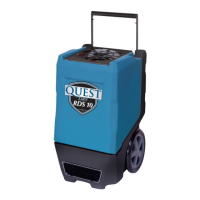1-866-933-7486
Quest Dry RDS 10 Installation, Operation and Maintenance Instructions
5
www.QuestOnTheJob.com
sales@QuestOnTheJob.com
Quest Dry RDS 10 Installation, Operation and Maintenance Instructions
quest
quest
3.2 Electrical Requirements
The Quest Dry RDS 10 plugs into a common grounded outlet on a 15 amp circuit. It draws 5.1 amps at 80°F,
60% RH. If used in a wet area, a ground fault interrupter (GFI) is required. If an extension cord is required, it
must have a minimum of 14 gauge conductors if 25 feet long or less and 12 gauge conductors if greater than
25 feet long.
3.3 Condensate Removal
The Quest Dry RDS 10 is equipped with an internal condensate pump to remove the water that is condensed
during dehumidication. This allows the condensate to be pumped 20 feet with the attached hose. If the
condensate must be pumped more than 20 feet above the unit, a second pump must be added to relay the
condensate. The condensate pump automatically purges for 20 seconds every eight minutes. Use the PURGE
button to manually remove condensation.
3.4 Ducting
A wire duct collar is supplied to allow 10” lay-at duct to be attached to the Quest Dry RDS 10 outlet. Lay-
at plastic ducting is available; see accessories table page 6. To attach ducting to the wire duct collar, put
the plastic duct end through the collar center and roll the duct end outward so that it overlaps the outside of
the collar. The duct and collar may then be quickly attached to the Quest Dry RDS 10 by snapping the collar
over the four exhaust tabs.
3.5 Defrost Cycle
If the low side refrigerant temperature drops due to excessive frost
formation on the evaporator coil and below the temperature set
point, the thermistor activates the solid-state control and defrost
light. The compressor is cycled off and on by the thermistor
temperature measurement. The air mover will continue to run,
causing air to ow through the evaporator coil and melt the ice
when the compressor is off. When the air temperature and/or
humidity increases, the evaporator temperature will rise and the
thermistor will end the defrost cycle at the temperature set point.
3.6 POWER Button
Press the POWER button to turn the dehumidier on or off. When starting the dehumidier the display will
show the accumulated hours. Press the POWER button again to turn the dehumidier off. The display will
also power off.
3.7 PURGE Button
During normal operation the pump automatically cycles every four minutes. Press the PURGE button to
remove condensate manually from the reservoir. There are several ways to manually remove water from the
reservoir:
1. Press the PURGE button once and the pump will run for 20 seconds
2. Press and hold the PURGE button and the pump will run for up to 30 seconds
3. Press the PURGE button while the dehumidier is powered off and the pump will run for 30 seconds.
Always manually purge the water reservoir before transport or storage. Turn off the power and allow the
plugged in dehumidier to rest 15 minutes before the nal purge.
Figure 2: Quest Dry RDS 10 control board.

